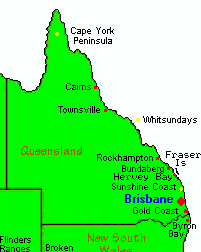Jemima's Place
FRASER iSLAND
  |
|
|
Fraser Island |
Fraser Island
lies off the southeastern coast of Queensland, Australia, separated from the mainland by the Great Sandy Strait and is the world's largest sand island. It is about 120 km (about 75 miles) long and ranges in width from about 7 to 22 km (about 4.5 to 14 miles). The island has multiple layers of sand deposits which make up the massive dune system, providing a geological record of climatic and sea level changes over the past 700,000 years. Tall rainforests soar out of the sand dunes which are up to 400,000 years old and rise to heights of about 240 m (about 787 ft). Rain forests grow on the sand dunes of Fraser Island, unlike on other sand islands. Hoop, kauri, blackbutt, and satinay trees are common. The glorious island is a drawcard for hundreds of thousands of people each year. It's idyllic settings, untouched rainforest, freshwater lakes, curious rock formations and spectacular flora and fauna have visitors mesmerised. The delicate environment originally developed from materials weathered from the mountain ranges of northern New South Wales. |
|
| Eliza Fraser
Fraser Island was named after a Scottish sea captain, James Fraser and his wife Eliza. Eliza Fraser and the First Mate, Brown, finally escaped with the assistance of one of the natives, since believed to be an escaped convict, David Bracewell, who had been living with the tribe. After a harrowing saga that lasted some two months, Eliza was eventually delivered to a rescue party Her story gained worldwide sympathy and notoriety She returned to England, her account of the tale growing in detail and horror with each telling. She received donations from a public appeal in Sydney and played upon the sympathies of audiences, eventually regaling her much embroided story to side-show audiences. |
|
Discovery Captain James Cook is credited with the official European discovery of Fraser Island in May of 1770, even though he did not realise it was an island. Cook gave names to many of the landmarks, names which still survive, but he was not the first European to the region. He was preceded in his discovery by as much as 250 years by the voyage of de Menonca, a Portugese explorer, who was thought to have visited the region around 1521. Dutch explorers were also thought to have visited before Cook, with relics at Indian Head dating back to the 17th century.
|
|
| Logging
It was in search of the grave of Captain Fraser that Andrew Petrie first visited Fraser Island. While he failed to find the grave, he did discover the wealth of kauri pine on the island. It was the catalyst for the region's settlement, though logging didn't commence for a further twenty years. A flamboyant American, John Piggott, known as `Yankee Jack', was the first of the island's timber- getters, felling kauri pine near Wanggoolba Creek and rafting it across Hervey Bay to Maryborough, where William Pettigrew had established the Dundathu Mill. Blackbutt and kauri had been the focus of much of the timber-getting, but by 1925, the qualities of Fraser's unique satinay were becoming noticed. Also known as turpentine trees, they resisted marine borers and didn't rot in sea water. Consequently satinay was prized and logs from Fraser were shipped worldwide. Some were used in the sidings of the Suez Canal and still more were used to re-build London Docks after World War II. |
|
| "Z" Force
During World War II a commando training station was established on Fraser Island, near McKenzie Jetty. With the Japanese having occupied Singapore, the commandos trained on Fraser Island for a daring raid known as Operation Jaywick. |
Fraser Island There are more than 40 deep freshwater lakes on the island, some of which are perched high above sea level. Lake Boemingen, the largest of these lakes, is almost 200 hectares (almost 495 acres) in area. Prior to European occupation the island was home to several thousand Aborigines. The island is exceptionally rich in plant life. There are well-preserved tidal marshes, subtropical rain forests and communities of mangroves on the western side of the island, and heaths and open forests on the east. |
| Central Station Central Station was once the hub of the forestry industry on Fraser Island, employing over 100 people. It is now a camping area with an Information Centre containing some of the history of the area. |
Shipwrecks and Lighthouses
More than 50 vessels have been wrecked in the waters and shores of Fraser Island and the Great Sandy Region. The area became of such concern that a 20 metre lighthouse was constructed at Sandy Cape on the northern tip of the island in 1870. |
| The Maheno
The Maheno was a 5282 ton triple screw turbine steamer luxury liner, accommodating 254 first class and 201 second class passengers. Built in Dumbarton, Scotland in 1905 it had a top speed of 19 knots and broke all previous records on the run between Melbourne and Sydney in 1905. At the beginning of World War II the ship was used as target practise by the Bunderburg aviation training school. Square holes remain in the middle section of the hull, resulting from World War II demolition practice by the Z force commandos, using limpet mines.The past 60 years of waves and weathering have reduced this once huge vessel to a small rusting hulk. |
|
|
|
.
